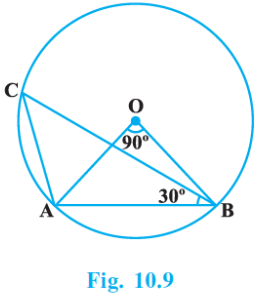In Fig. 10.9, ![]() AOB = 90 � and
AOB = 90 � and ![]() ABC = 30 �, then
ABC = 30 �, then ![]() CAO is equal to:
CAO is equal to:

Given: ∠AOB = 90°, ∠ABC = 30°
OA and AB are radius and are equal,
∴ ∠OAB = ∠OBA = x (say) (∵ angles opposite to equal sides are equal)
In triangle OAB, using the angle sum property, sum of all angles of triangle is 180°.
∴ ∠AOB + ∠OAB + ∠OBA = 180°
⇒ 90° + x + x = 180°
⇒ 2x = 180° - 90°
⇒ 2x = 90°
⇒ x = 45°
∴ ∠OAB = ∠OBA = 45°
Since angles in the same segment are equal, therefore
∠ACB = ∠OAB = 45° (∵ ∠OAB = 45° and these angles lie in the same segment CB)
Now, in triangle CAB, using the angle sum property of triangle, sum of all angles is 180°.
∴ ∠CAB + ∠ABC + ∠BCA = 180°
⇒ ∠CAB + 30° + 45° = 180°
⇒ ∠CAB = 180° - 30° - 45°
⇒ ∠CAB = 105°
⇒ ∠CAO + ∠OAB = 105° (∵ ∠CAB = ∠CAO + ∠OAB)
⇒ ∠CAO + 45° = 105°
⇒ ∠CAO = 105° - 45°
⇒ ∠CAO = 60°
∴ ∠CAO = 60°